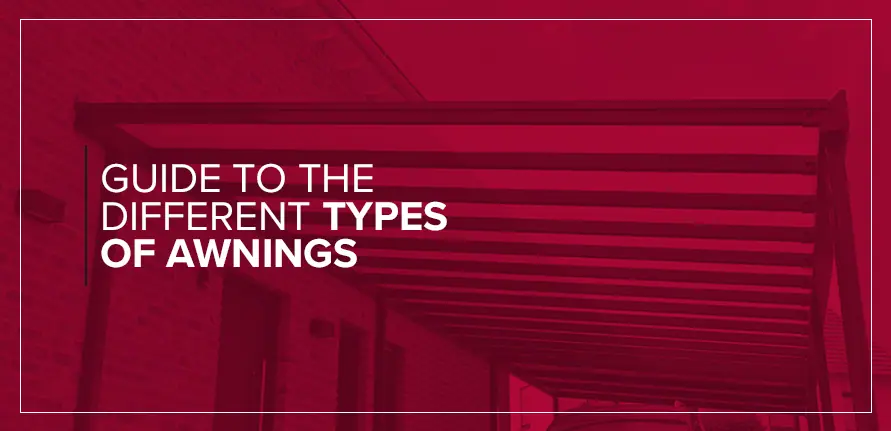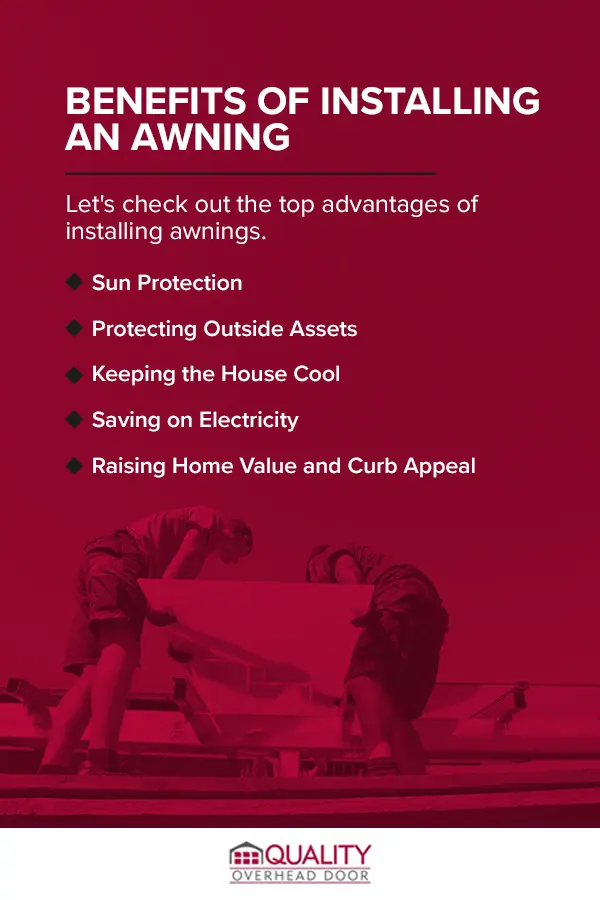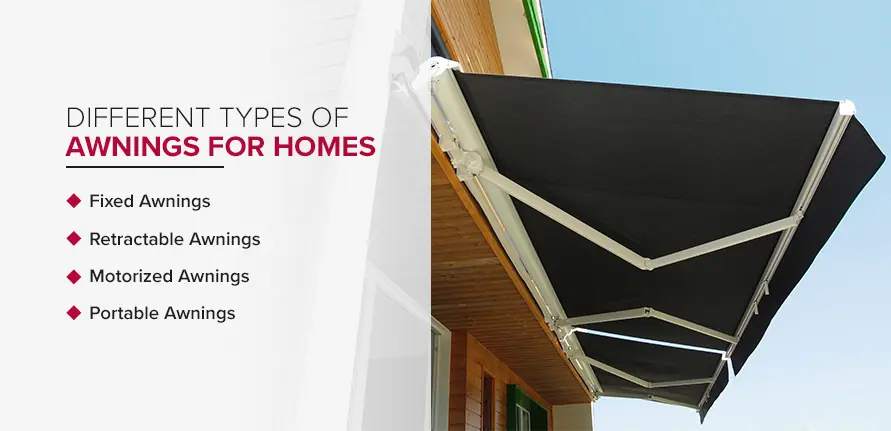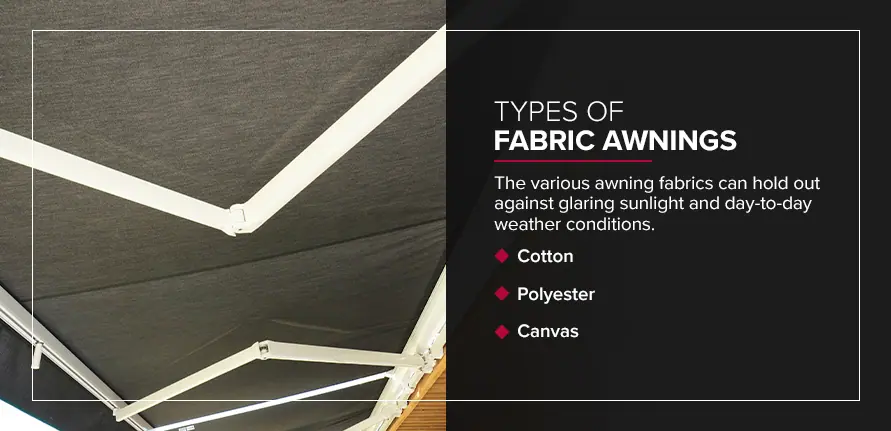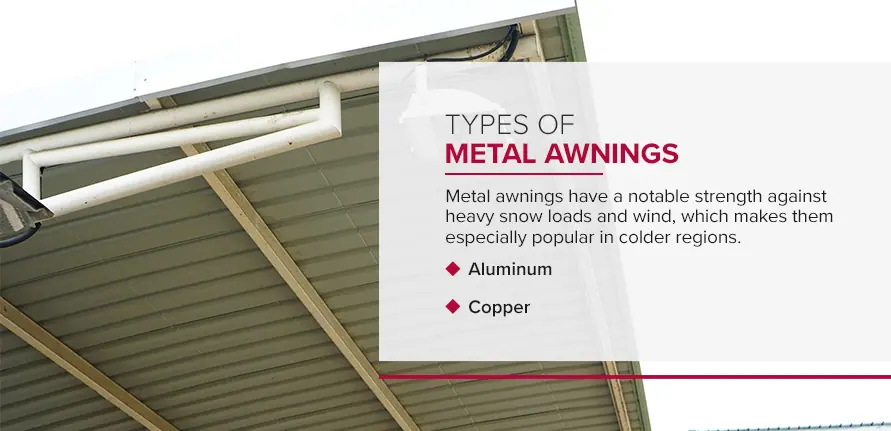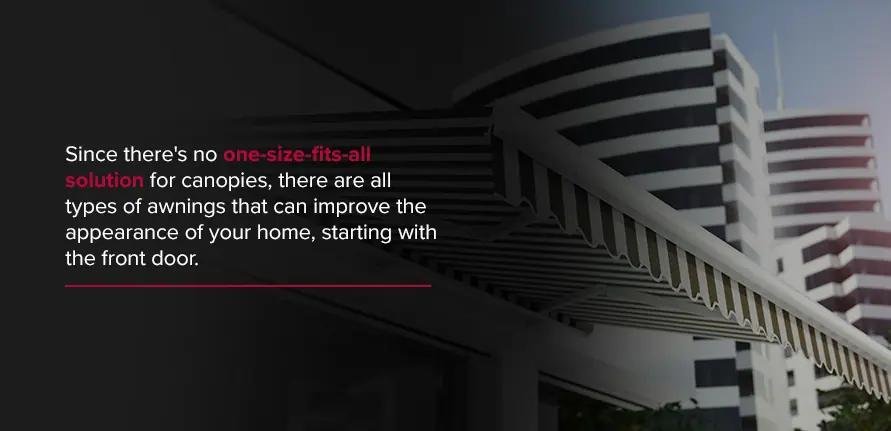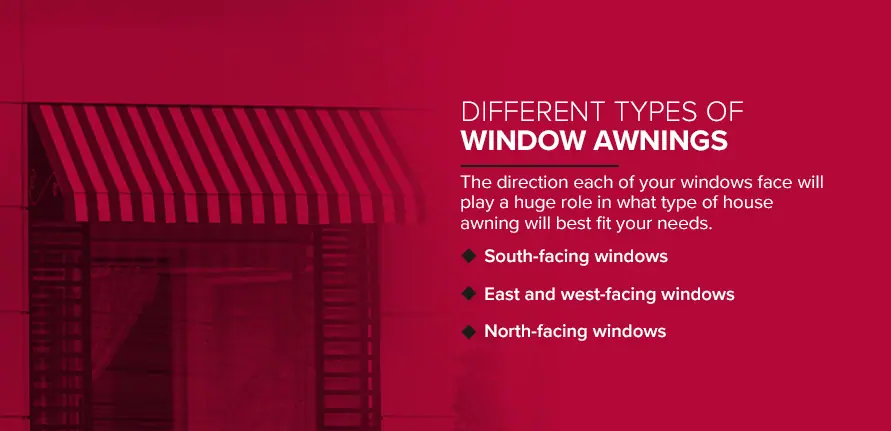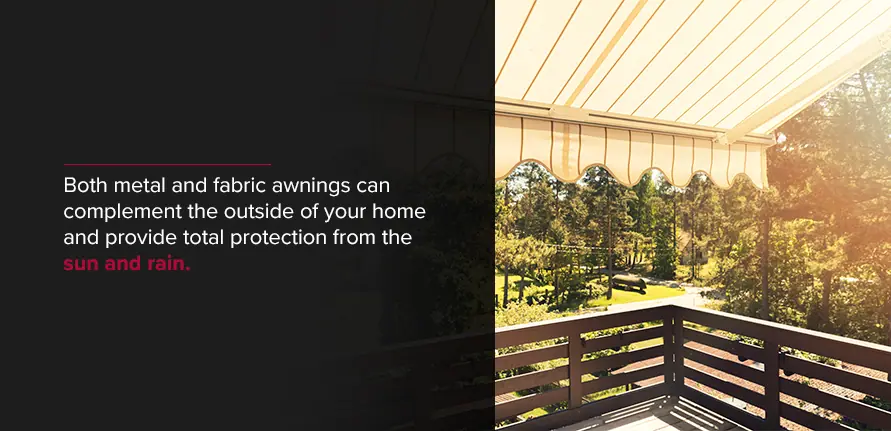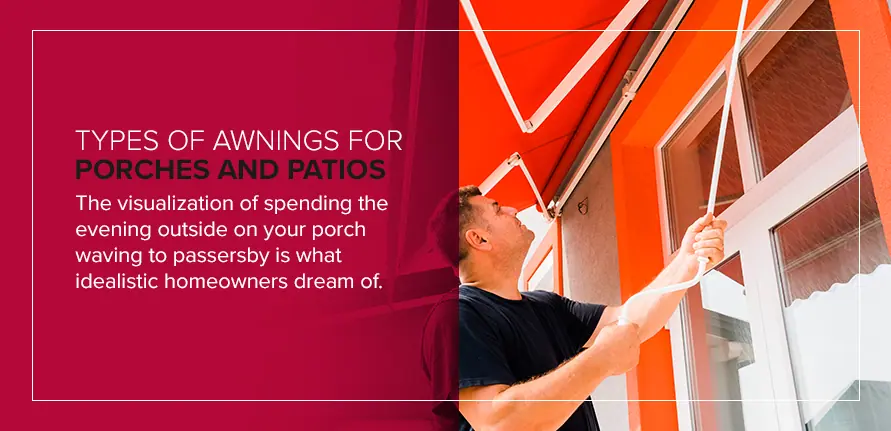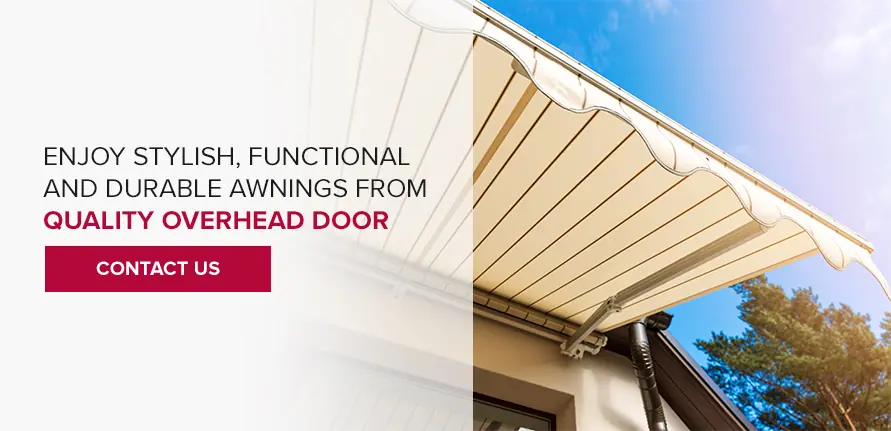As the weather heats up, homeowners will do anything to keep the house cool. Many homes have air conditioning systems, but constant use drives electric bills through the roof. Some people keep their blinds closed and resort to cooking without using their stoves. Instead of turning to extreme solutions, you can easily control the temperature of your house while also increasing the value of your home and minimizing energy costs with a new awning.
Many homeowners want to enhance their homes with awnings but don’t know where to start. Between the different types of awnings for homes, types of awning fabrics and colors, it isn’t always easy to make a selection. This investment will last years, so you want to make the right choice.
This guide breaks down everything you need to know about adding awnings to your home. From the different types of awnings to the best types of awning cover fabric, finding what type of awning material is best for your home will be easier than ever. Soon, you’ll be relaxing on your deck with a cold beverage, enjoying the weather in the shade.
Keep reading to learn everything you need to know about selecting the perfect awnings for your home.
Benefits of Installing an Awning
Like any other exterior addition, awnings can significantly improve the appearance of your home. However, there are other benefits of adding an awning you may not even realize. These benefits prove that awnings are more than a decoration — they’re an asset. From sun protection to indoor temperatures to energy costs, installing an awning can bring you and your family numerous advantages.
Let’s check out the top advantages of installing awnings.
1. Sun Protection
Did you know that more people are diagnosed with skin cancer each year than the total amount of all other cancers? In fact, it’s believed that at least one in five people will be diagnosed with some form of skin cancer by the age of 70. Whether you regularly apply sunscreen or save it for beach days, there’s no denying the dangers of too much sun exposure.
If you’re a shade-dweller, you already know the relief an awning can provide. Additionally, awning covers protect you and your family from harmful ultraviolet (UV) rays during the warmer months. Getting outdoors becomes safer and more enjoyable when you have a way to hang out under an awning.
2. Protecting Outside Assets
You’ve finally bought a beautiful outdoor furniture set, and your back porch is looking more welcoming than ever. Unfortunately, lawn furniture isn’t always built to last under the constant exposure of Mother Nature. From scalding heat waves to mountainous snowstorms, your outdoor items are constantly subjected to conditions that cause greater wear, tear and deterioration. Awnings prevent sun damage to your outdoor chairs and tables, so your picture-perfect backyard can remain intact.
3. Keeping the House Cool
Exposure to natural light can boost your mood and make a room feel open and inviting. However, lots of windows also increase the temperature of your house significantly. Without proper coverage, your home essentially becomes a greenhouse. Heat gets trapped in your house, and running the air conditioning all day isn’t an effective way to battle the sun.
While closing the blinds is one way to keep the sun out, they hinder your visibility and darken the room. Customized awnings block UV rays before they reach your house, which is more effective than blinds or curtains. Plus, they eliminate glares on your computer and television screens. Window awnings allow you to enjoy the sun’s natural light so you don’t have to sit in the dark on beautiful sunny days.
4. Saving on Electricity
Awnings are a great way to reduce your carbon footprint and save money. A strategically placed awning can lower your electric bill by ensuring your house stays cool enough during the summer. Specifically, retractable awnings go a lot further regarding savings. During the winter months, a retractable awning allows you to let in sunlight so your home stays heated. It’s a win-win situation — for you and the environment!
5. Raising Home Value and Curb Appeal
Along with adding character to your home, awnings complement your house’s structure and features. Depending on the types of awnings and what type of fabric is used for an awning, your home’s curb appeal will instantly improve. That’s not the only way awnings increase property value.
Unless you renovate your house, you can’t add rooms or square footage. However, awnings create usable outdoor space where there wasn’t any before. They make your porches and decks accessible and livable for a greater part of the year. Awnings add space for entertaining guests and create a comfortable ambiance, as well. If you end up selling your house, you’ll likely see that potential homebuyers are interested in those spaces, too.
Different Types of Awnings for Homes
Every house is different, so choosing the best type of awning for your home depends on various factors. There are different types of awnings, and each of them offers its own benefits when it comes to style and convenience. You want to choose a design and material that match the aesthetic of your home and can hold up against your region’s typical weather conditions. This breakdown will make finding the right awning for your house simple.
1. Fixed Awnings
When most people think of awnings, they picture large metal poles secured to the house. Fixed awnings, also known as stationary awnings, are attached to a building’s exterior. They’re stable and reliable solutions built to withstand varying weather conditions.
When installing a fixed awning, it’s crucial to have an expert installer evaluate the space. Since fixed awnings often have to endure intense weather situations, you’ll need to invest in a durable canopy fabric that can collect falling rain and snow. If you live in a region that experiences heavy rain, snowfall and wind, a professional will be able to recommend the material and style that will best serve your home.
Remember that fixed awnings are there to stay, so make sure you know exactly where you want it before having it installed.
2. Retractable Awnings
Retractable awnings are canopies that roll or fold up. They’re a great option because they offer versatility for your windows, doors, decks and patios. When needed, they block out the elements and provide shade. Plus, when you want to soak up the sun, you can easily put them away. In less than a minute, your sunny patio turns into a shady oasis when you choose from different types of patio awnings.
Retractable awnings are the most common because of their flexibility. They’re also relatively easy to maintain because you can store them when the forecast predicts adverse weather conditions. If you love incorporating technological elements into your home’s design, different types of retractable awnings can modernize your home.
3. Motorized Awnings
When it comes to convenience, look no further than motorized retractable awnings. Standard retractable awnings rely on a handle or hand crank to extend and retract. However, motorized types of retractable awnings can be programmed with a sensor, remote control, button or even a motion trigger. While motorized options will be slightly more expensive, they can save you time and money in the long run. Retractable awnings last longer than their stationary counterparts because you can store them during bad weather, so they sustain less damage.
Sensor-triggered awnings take it one step further. They can be programmed to extend when the sunlight beams down, or when the rain starts to fall. They can also automatically roll back up when it gets windy. Motorized canopies don’t just give your home an aesthetic edge — they allow you to make use of the total space of your property without letting environmental factors get in the way.
4. Portable Awnings
Portable canopies awnings, also known as freestanding awnings, can move from one place to another depending on where you need them. The convenience of portable awnings is that you can move them to follow the sun’s path, so you’re always protected under the shade. Freestanding canopies aren’t attached to a structure, while still providing more coverage than a standard umbrella. However, one notable downside is they aren’t as sturdy as other options because they aren’t secured to a building.
Types of Fabric Awnings
At this point, you may be wondering what type of materials awnings are made of. You’ve probably seen metal, plastic and fabric coverings in the past on different homes, restaurants and office buildings. All of the options available offer similar advantages, but not all of them will fit the aesthetic of your home or provide the benefits that you’re looking for. The various awning fabrics can hold out against glaring sunlight and day-to-day weather conditions. Different types of cloth awnings include cotton, polyester and canvas.
- Cotton: Cotton awnings are among the most identifiable options. They’re affordable, versatile, waterproof and breathable. Plus, they’re easy to maintain. To clean them, all you have to do is put them in your washing machine.
- Polyester: Polyester awnings are known for their ease of maintenance. Simply wiping them down with a cloth will keep them in good standing for years to come. Polyester canopies are a great option for letting in sunlight while still blocking harmful ultraviolet rays. They’re also lightweight, mildew-resistant and budget-friendly.
- Canvas: This material offers a classic, natural look for your home and deck. Canvas is a durable solution that comes in a variety of colors and designs. By combining cotton with synthetic fibers, canvas becomes weather resilient and water-resistant. However, it’s important to note that certain printed patterns may fade over time due to excessive sun exposure.
Fabric awning covers are usually treated with either vinyl or laminate coatings. These treatments will make your awning materials flame- and water-resistant, but keep in mind they’re still prone to fading.
Types of Metal Awnings
You also have to option of choosing metal awnings to accessorize your home. Metal solutions come with a larger price tag but are more resilient to weather and wear. Metal awnings have a notable strength against heavy snow loads and wind, which makes them especially popular in colder regions.
- Aluminum: This versatile metal is extremely low maintenance and won’t absorb heat. Different types of aluminum awnings are resistant to UV radiation, and are strong, recyclable and impact-resistant.
- Copper: For trendsetters and homeowners who appreciate craftsmanship, copper awnings are a beautiful ornamental solution. Copper awnings are resistant to corrosion, high temperatures and UV degradation.
If you’re considering using metal awnings, you should know that some metal materials absorb and transfer heat. Depending on your home’s sun exposure, copper and other metal awning materials may not be an ideal solution. Make sure to weigh your options or ask our team of highly trained experts — we’re here to help you find what type of awning will work best for your situation.
Polycarbonate Awnings
Somewhat similar to the concept of metal awnings, polycarbonate is an engineered thermoplastic material that’s strong and sometimes transparent. In fact, this material is so tough it’s virtually indestructible, on top of providing protection from UV rays. As a result, you can enjoy total protection with minimal maintenance needs. Polycarbonate is used in many everyday household items like electronics, as it features dimensional stability, minimum water absorption and high impact resistance. All of these features make it an optimal choice for your home.
Types of House Awnings
You may be wondering how an awning fits into the appearance and functionality of your house. Would individual canopies for each window look right? Do you need one giant awning to cover your entire back porch? Awnings come in all shapes and sizes, so you can browse the various types of home awnings to find one that uniquely fits your house.
If a friend or family member has invested in modern awnings, they’ll likely be able to tell you what factors lead to them choosing the materials, colors and shape. However, there’s a chance their canopy design and material won’t fit your home’s aesthetic or needs. This guide will show you all the different places you can install an awning, and why the direction of your windows has such a significant impact on choosing the right awning for your home.
Types of Awnings for Doors
Since there’s no one-size-fits-all solution for canopies, there are all types of awnings that can improve the appearance of your home, starting with the front door. Whether you have a small stoop or a quaint porch, door awnings, also called overhangs, are designed to protect your entryways from most types of inclement weather. After all, what’s worse than standing in the rain while fumbling for your house keys?
Most door canopies are stationary, so they provide coverage year-round while still allowing complete mobility when opening your door. Along with adding a certain charm to your home’s exterior, door awnings keep your steps and stoop clean. Common door awnings styles include dome, elongated dome, entrance canopy and slope.
Different Types of Window Awnings
Window awnings are both attractive and energy-efficient. By adding window awnings to your home, you cut down on energy costs and enhance your home’s curb value. Awnings with sides are typically recommended for windows, as they do a better job at deflecting the sun’s beams throughout the day, regardless of where the sun is in the sky. The direction each of your windows face will play a huge role in what type of house awning will best fit your needs.
- South-facing windows: South-facing windows receive more heat and sunlight than windows facing north or east. As a result, it’s important to install awnings for these windows — they can decrease heat gain by up to 65%.
- East and west-facing windows: Big windows are usually a huge plus when it comes to finding the right home. But if you have windows that face east or west, it means constant sun exposure. You can reduce solar heat gain by adding awnings above east- and west-facing windows. Afternoon sunlight is known for being hotter, so awnings with sides will provide the best coverage.
- North-facing windows: Windows facing north tend to get the most sunlight in the early morning, so a simple overhang, slated or shutter style awning will offer the right amount of shade.
Types of Awnings for Decks
Decks provide the perfect location for family dinners and social gatherings. That said, on a blistering hot day, the last place your guests will want to be is outside on your deck. Canopies can help create a desirable ambiance that will leave your neighbors envious. Both metal and fabric awnings can complement the outside of your home and provide total protection from the sun and rain. This concept leaves plenty of room for style and color customization.
Retractable awnings are the ideal choice, as they cover the entirety of the deck with one piece of fabric. However, depending on which direction your deck faces, you may want to consider types of deck awnings that have extendable sides. This way, your guests will be protected from the sun and insects no matter the time of day.
Types of Awnings for Porches and Patios
A screened-in porch is an ideal feature for many homeowners. The visualization of spending the evening outside on your porch waving to passersby is what idealistic homeowners dream of. Unfortunately, if you don’t have a roof or covering overhead, your moment is hindered by over-exposure to the sun. What should be a space for socialization and relaxation become uncomfortable by sun glares and mosquitos. Luckily, different types of porch awnings can make your patio comfortable and accessible.
For example, aluminum awnings are low maintenance and have the durability to last for many years. Each type of awning shares these similarities, resistance to color-fading and other signs of wear and distress from environmental and external factors.
Enjoy Stylish, Functional and Durable Awnings From Quality Overhead Door
At Quality Overhead Door, we’ve been servicing Toledo since 1982. As your neighbors, we know what materials stand up to the region’s range of weather conditions. From ornamental style to minimalistic designs, we offer a wide variety of awnings and canopies to provide the perfect accent for your home. If you’re unsure about the different types of awnings for your home, we can help.
We pride ourselves on our commitment to quality, so all of our awnings come from the industry’s most respected and trusted manufacturers. That means we only offer the most durable, proven solutions for every awning type and style you want to feature in your home. From the most advanced awning with sun sensors and remote controls to standard UV protection, we’ve got you and your porch protected and covered.
Contact our experts today for a free estimate.
Additional Resources on Awnings:
- Common Awning Problems and How to Avoid Them
- How to Choose the Right Awning for Your Home
- How to Protect Your Patio from the Elements
- Why Retractable Awnings May Be the Perfect Option for Your Patio

